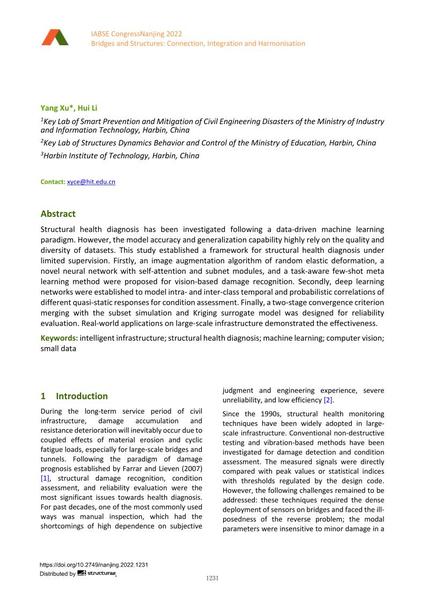Structural Health Diagnosis Under Limited Supervision

|
|
|||||||||||
Bibliografische Angaben
| Autor(en): |
Yang Xu
(Key Lab of Smart Prevention and Mitigation of Civil Engineering Disasters of the Ministry of Industry and Information Technology, Harbin, China; Key Lab of Structures Dynamics Behavior and Control of the Ministry of Education, Harbin, China; Harbin Instit)
Hui Li (Key Lab of Smart Prevention and Mitigation of Civil Engineering Disasters of the Ministry of Industry and Information Technology, Harbin, China; Key Lab of Structures Dynamics Behavior and Control of the Ministry of Education, Harbin, China; Harbin Instit) |
||||
|---|---|---|---|---|---|
| Medium: | Tagungsbeitrag | ||||
| Sprache(n): | Englisch | ||||
| Tagung: | IABSE Congress: Bridges and Structures: Connection, Integration and Harmonisation, Nanjing, People's Republic of China, 21-23 September 2022 | ||||
| Veröffentlicht in: | IABSE Congress Nanjing 2022 | ||||
|
|||||
| Seite(n): | 1231-1239 | ||||
| Anzahl der Seiten (im PDF): | 9 | ||||
| DOI: | 10.2749/nanjing.2022.1231 | ||||
| Abstrakt: |
Structural health diagnosis has been investigated following a data-driven machine learning paradigm. However, the model accuracy and generalization capability highly rely on the quality and diversity of datasets. This study established a framework for structural health diagnosis under limited supervision. Firstly, an image augmentation algorithm of random elastic deformation, a novel neural network with self-attention and subnet modules, and a task-aware few-shot meta learning method were proposed for vision-based damage recognition. Secondly, deep learning networks were established to model intra- and inter-class temporal and probabilistic correlations of different quasi-static responses for condition assessment. Finally, a two-stage convergence criterion merging with the subset simulation and Kriging surrogate model was designed for reliability evaluation. Real-world applications on large-scale infrastructure demonstrated the effectiveness. |
||||
| Copyright: | © 2022 International Association for Bridge and Structural Engineering (IABSE) | ||||
| Lizenz: | Die Urheberrechte (Copyright) für dieses Werk sind rechtlich geschützt. Es darf nicht ohne die Zustimmung des Autors/der Autorin oder Rechteinhabers/-in weiter benutzt werden. |
||||
